To enjoy your gifts under the tree 🎄: we recommend ordering before 12/17
First order? 1 free maracas dumbbell Confetti with the code BIENVENUE-JANOD
From €150 purchase: 1 free mini xylophone with the code CONFETTI25 ✨
Free delivery for purchases over €40
Free shipping from €40 of purchase 🎁
Vous devez avoir un compte pour pouvoir utiliser cette fonctionnalité.
Connexion InscriptionReading time: 13 minutes
Introducing children to the world of music from an early age can have a significant impact on their cognitive, sensory, and emotional development. Musical instrument toys play a key role in this awakening process.
In this guide, we'll help you choose the best musical toys for children aged 18 months to 7 years, taking into account several important factors such as age appropriateness, safety, and educational value of the toys.
Summary :
Here is a list of 3 criteria to consider when purchasing a musical toy for your child:
Did you know? Sound-producing toys are subject to specific standards to protect children's hearing. A European directive sets the maximum decibel limit that can be emitted by sound-producing toys: they must not exceed 80-85 decibels at a distance of 50 cm.
The CE marking, mandatory for all toys sold in the European Union and present on all our toys, indicates that the manufacturer declares that the product complies with the safety requirements of the European directive. It is crucial to be wary of products that do not have this marking.
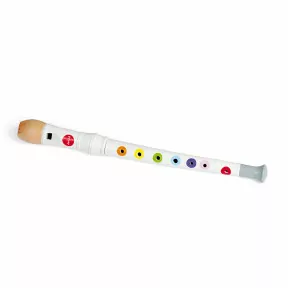
Flute Confetti (wood)
CONFETTI Wooden flute (8 pieces in a display). Red, yellow, green, orange. Confetti, a complete line of musical toys featuring Pop N’ Rock designs! Confetti awakens all of the senses and introduces the youngest musicians to the joys of musical improvisation.
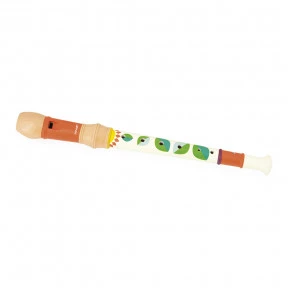
Gioia flute
Ready for a musical show? This wooden flute is suitable for children aged 3 and over. You'll have to work on your breathing! Ideal for developing a taste for music and musical talent from a very early age, this musical toy comes in pretty colors: those of our Gioia range. The natural wood is adorned with bright colors, for a resolutely festive style! With their musical instrument toy, children can imagine their own melodies and imitate the grown-ups with their very own instrument. Its 31 cm size makes it easy for little ones to hold and use. The whole family can dance to the beat with this imitation toy! It's part of our Gioia range, a joyful invitation to musical awakening, enabling little ones to discover the world of sounds in a playful, sharing way. Toy flute made from wood from sustainably managed forests, FSC™ certified. It's time for the concert!
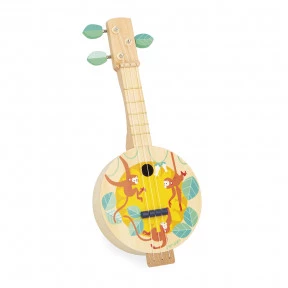
Banjo Jungle Gioia
Hello, banjo! This wooden banjo is suitable for children aged 3 and over. It features 3 strings and 3 tuning keys to imitate the instruments of the grown-ups. Ideal for developing a taste for music and musical talent, this musical toy comes in pretty colors: those of our Gioia range. These three monkeys can't wait to see what melodies will come out of this children's banjo! With their musical instrument toy, children can imagine their own melodies and imitate the grown-ups with their very own instrument. Measuring 18 x 44 cm, it's easy to hold and super-simple for little ones to use. It comes with 3 spare strings. The whole family can dance to the beat with this imitation toy! It's part of our Gioia range, a joyful invitation to musical awakening, enabling little ones to discover the world of sounds in a playful, sharing way. Banjo Jungle made from wood from sustainably managed forests, FSC™ certified. Make way for musical awakening!
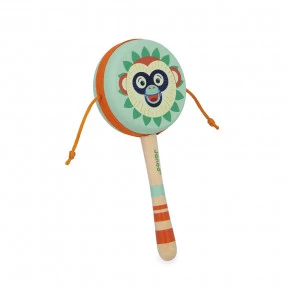
Gioia Monkey Hand Drum
Be the percussion master! This hand drum is suitable for children aged 2 and over. It's super-simple to play: place the handle between your hands, and roll it back and forth. Adjust the speed to create slow sounds, or faster, more rhythmic ones. Ideal for developing a taste for music and musical talent, this musical toy comes in pretty colors: those of our Gioia range. We're all crazy about this cheeky monkey! With their wooden hand drum, children can imagine their own melodies and imitate the grown-ups with their very own instrument. Its 17.5 cm size makes it easy for little ones to hold and use. The whole family can dance to the beat with this imitation toy! It's part of our Gioia range, a joyful invitation to musical awakening, enabling little ones to discover the world of sounds in a playful, sharing way. Hand drum made from wood from sustainably managed forests, FSC™ certified.
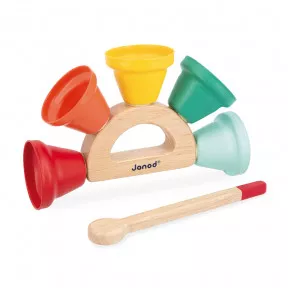
Gioia bells
Joy to your ears! This musical toy is bound to delight babies aged 18 months and up. It comprises 5 pretty metal bells which are attached to a wooden handle, and a stick to ring them; this early-learning sound toy is truly enchanting. This easy-to-grip early-years toy offers a fun introduction to sounds. The coloured bells stimulate visual acuity, their sound promotes musical awareness and by using the wand, movement coordination is improved. Each bell produces a different sound, allowing toddlers to discover the nuances of sound and develop an ear for music. With this early-years toy, babies can put on their own concert at home! They will have fun ringing the bells, reacting to the different sounds and letting the whole family join them on this musical adventure. This toy musical instrument is part of our Gioia range; a joyful musical awakening is in store for little ones as they discover many a sound in a fun, sharing-focused way. FSC™-certified wooden toy.
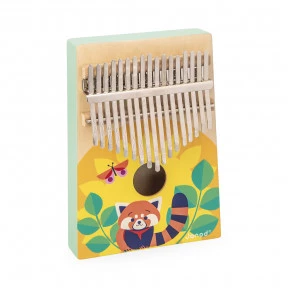
Kalimba Gioia
You'll be thrilled by these sweet tones! This kalimba is suitable for children aged 3 and over. This instrument of African origin offers 17 tones thanks to the metal keys, each of which emits a different sound. Ideal for developing a taste for music and musical talent, this musical toy comes in pretty colors: those of our Gioia range. We're all crazy about this adorable red panda! With their wooden kalimba, children can imagine their own melodies and imitate grown-ups with their very own instrument. Its rectangular shape and 13 x 18.5 cm size make it easy to hold. The whole family will love the soft, poetic sounds of this imitation toy! It's part of our Gioia range, a joyful invitation to musical awakening, enabling toddlers to discover the world of sounds in a playful, sharing way. Kalimba made of wood from sustainably managed forests, FSC™ certified.
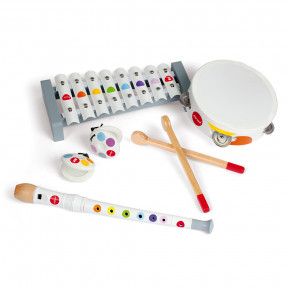
Musical Set Confetti (wood)
The tools of the perfect little musician! This wooden music set includes 4 toy musical instruments for children aged 2 years and over. It allows children to try out different instruments and find their favourite or to create their own music group with their brothers, sisters and friends. Your children will have fun blowing the flute, shaking the cymbal tambourine, tapping the xylophone or shaking the castanets in their hands! Discovering different sounds, awakening their senses and learning about musical improvisation, your young children will not be able to do without these beautiful toys. Confetti is a complete range of musical toys full of colour and joy with Pop N' Rock motifs!
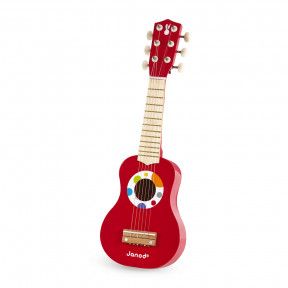
My First Guitar Confetti (wood)
Does your child have the soul of Jimi Hendricks? Would you like to give him the opportunity to imitate the greatest musicians? This pretty wooden guitar with 6 metal strings will allow your budding musician to discover the joys of musical improvisation from the age of 3. Let them discover this new toy at their own pace, which will help them develop their hearing and touch, and have a front row seat for their first steps into the world of music. Find all our other children's musical instruments from the Confetti range, musical toys with Pop N' Rock colours!
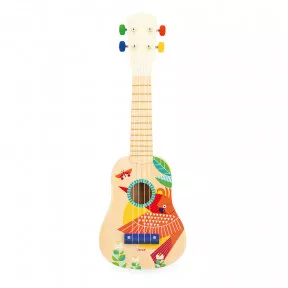
Gioia Ukulele
Are you ready to get the crowd on their feet? Introducing our children’s ukulele, a toy musical instrument that promotes the imagination and musical awakening of children aged 3 years and up. With its 4 nylon strings, just like a small guitar, it produces a cheerful sound that prompts musical experimentation. This wooden ukulele can easily be grasped, even by little ones, thanks to its specific size. An extra set of strings is also included in the box. With this musical toy, children can explore the world of music, develop their dexterity and even compose their own melodies! Furthermore, this ukulele will let them dream of becoming the biggest stars around! With its vivid jungle-hued design, this pretend play toy will appeal to children and parents alike. In summary, this little guitar is the perfect gift for budding musicians. It provides a fun yet educational musical experience, whilst also being a beautiful addition to your child's bedroom. This toy musical instrument is part of our Gioia range; a joyful musical awakening is in store for little ones as they discover many a sound in a fun, sharing-focused way. FSC™-certified wooden toy.
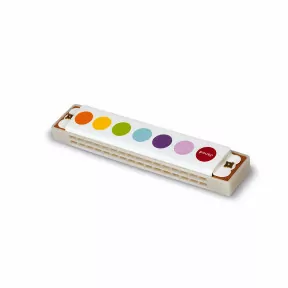
Harmonica Confetti
Confetti metal harmonica, sold in a display of 12 pieces, with a white wedge with a slot for each harmonica to make them stay vertical. Hangtag fixed to the harmonica with a plastic link. Red, yellow, green, orange... Confetti, a complete line of musical toys featuring Pop N' Rock designs ! Confetti awakens all of the senses and introduces the youngest musicians to the joys of musical improvisation.
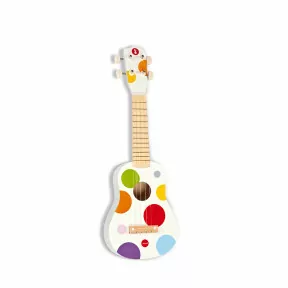
Ukulele Confetti (wood)
Let the music play! This wooden ukulele for children aged 3 years and up will delight musicians in the making. This ukulele boasts 4 nylon strings, a colourful design and is part of our Confetti range: a line of musical instrument-imitating toys featuring Pop N' Rock motifs! What a joy it will be for your child to have their own "grown-up" instrument and put on a show; it will allow him to build their self-confidence, in addition to varying their sensory experiences. There’s a star in the making!
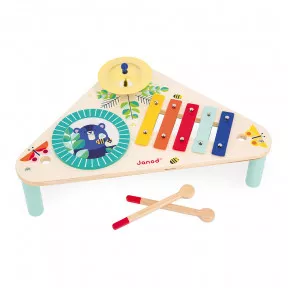
Gioia Musical Table
Let imagination resonate! Immerse yourself in a world of sounds and rhythms with our wooden musical table for babies aged 12 months and up. This early-learning musical toy is a real orchestra at your fingertips. It comprises 3 instruments: a drum, cymbal and a five-tone metal xylophone. Each instrument will introduce little ones to music as they discover the world of sounds in a fun and interactive way. Furthermore, this musical table boasts an integrated storage space for the drumsticks, so you won’t have to worry about losing them. Imagine your child’s joy-filled face as they hold the two sticks provided and explore the different sounds each instrument can produce. Each drum beat, cymbal chime or xylophone tone is a new musical adventure. In short, our wooden musical table for children is much more than a simple early-years toy. Musical exploration is on the cards as it opens the door to a universe of baby-suitable sounds and rhythms. Take the time to point out all the activity table’s pretty illustrations to your child: bees, butterflies and their new friend, the bear! So, are you ready to embark on a musical adventure? This sound toy is part of our Gioia range; a joyful musical awakening is in store for little ones as they discover many a sound in a fun, sharing-focused way. FSC™-certified wooden toy.
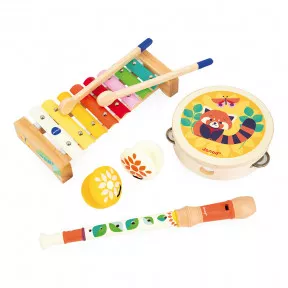
Gioia musical set
Share the love of music! With this set of 4 musical toys, younger and older children alike can be introduced to the joys of musical art from age 18 months and up. A sound toy is a great way to stimulate baby’s hearing whilst introducing them to different sounds. Children aged 3 years and up will have fun imitating the grown-ups and enjoying their fifteen minutes of fame with their very own pretend play musical toy! This set of toy musical instruments includes: 1x 8-tone wood and metal xylophone with 2 mallets, 1 nicely illustrated tambourine, 1 colourful wooden flute and 2 lively castanets. I.e. 4 toys dedicated to a shared musical awakening! This set of children’s musical instruments is ideal for offering a variety of sounds to baby or setting up a group concert. Each product produces a different sound and is manipulates in a specific way, making this set of toy instruments a perfect birthday gift for the most curious or aspiring musicians! Ideal for developing children's imagination, as they headline a fully-booked concert or give a music theory lesson to their stuffed animals. Which musical toy will become their favourite? And yours? This set of 4 pretend play toy musical instruments is part of our Gioia range; a joyful musical awakening is in store for little ones as they discover many a sound in a fun, sharing-focused way. Made from FSC™ -certified wood.
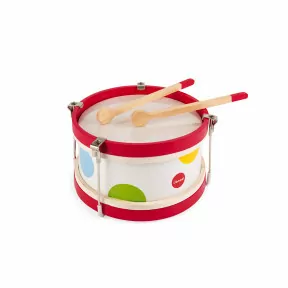
My First Drum Confetti (wood)
Let the beat continue with this beautiful wooden drum! Children aged 2 years and up will be able to experiment with sounds and learn about music, whilst also building self-confidence. This drum is part of our Confetti range: a line of musical instrument-imitating toys featuring Pop N' Rock motifs! Two drumsticks are included. How proud your little rock star will feel as they play their own instrument.
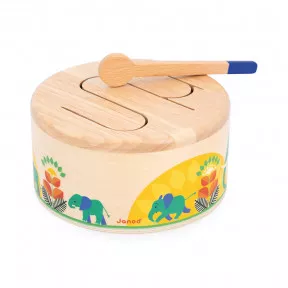
Drum Gioia
Drum away baby! Discover our wooden baby drum that’s suitable for budding musicians aged 18 months and up. This musical toy will introduce your child to the joys of music and promote their sound awareness. This wooden drum can easily be grasped, even by little ones. Pick up the drumstick and prepare to make sounds resonate. Thanks to this early-learning musical toy, little ones can explore the world of music and develop their sense of rhythm! Its key to introduce babies to a variety of sounds from a very early age. This will help with their development, whilst also keeping them entertained! And if there's one thing your child is bound to master at around 18 months, it's drumming and banging their toys. It is in these moments that they understand the cause and effect relationship. By gifting them a toy musical instrument, you are reinforcing this learning, whilst introducing them to sounds! This little drum measures 15.5 cm in diameter and also features all-over beautiful illustrations: the adventures of a young elephant. Offer this early-years toy to baby and narrate this story, show them how to make music and give them room to experiment! Little ones will be surprised by the soft sounds this wooden drum can produce. This toy musical instrument is part of our Gioia range; a joyful musical awakening is in store for little ones as they discover many a sound in a fun, sharing-focused way. FSC™-certified wooden toy.
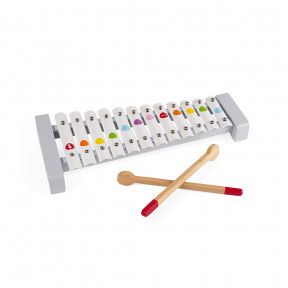
Metal Xylo Confetti
Wooden xylophone with 12 ferric pieces and 2 sticks. Red, yellow, green, orange... "Confetti" , a complete line of musical instruments featuring Pop N’ Rock designs! "Confetti" awakens all of the senses and introduces the youngest musicians to the joys of musical improvisation.
18 months - 3 years: At this age, children are drawn to sounds and textures. Toys like xylophones , drums , and maracas are great for encouraging sound exploration and fine motor skills.
3-5 years: Children begin to imitate adults and show more interest in role-playing. Instruments like toy guitars , children's pianos , and percussion sets allow children to pretend to play real instruments.
5-7 years : At this age, children can begin to understand the concepts of rhythm and melody. More complex instruments like electronic keyboards , junior drum kits , and ukuleles are ideal for developing their musical skills.
They gave their children a Janod musical pretend play toy and told us why they love it:
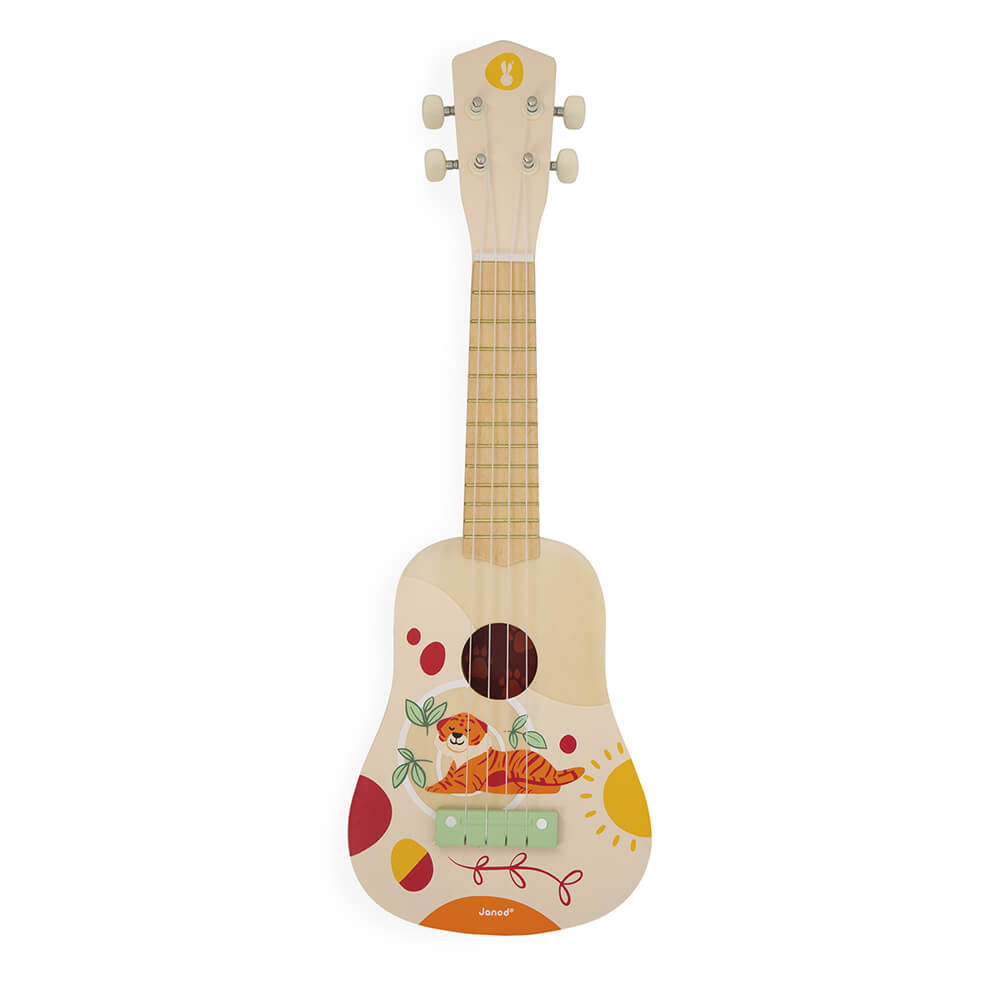
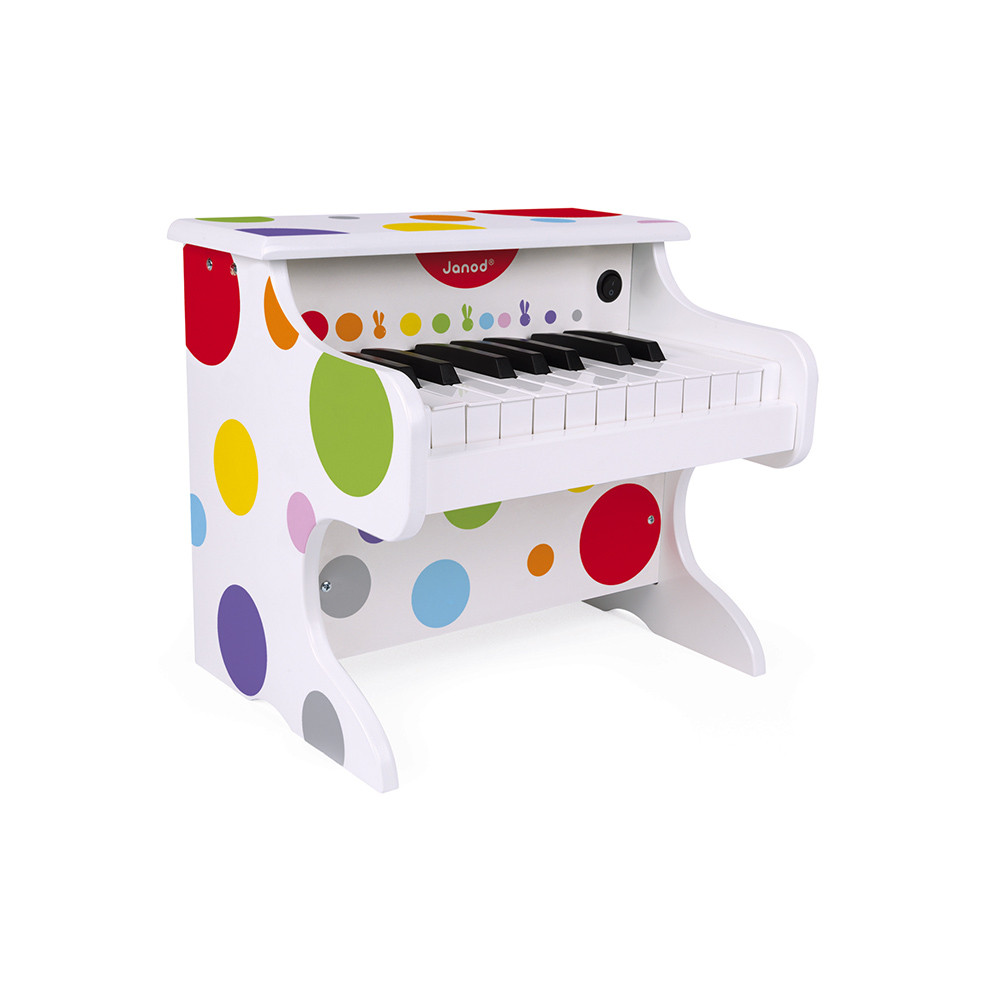
Our musical toys are designed primarily to awaken children's senses and introduce the concept of music in a fun and educational way. While our toys are inspired by real instruments and produce melodious sounds, they are not intended to formally teach music or replace real musical instruments. Their primary goal is to stimulate imagination, encourage sound exploration, and develop cognitive and motor skills in young children.
We encourage parents who wish to introduce their children to more structured musical learning to consider music lessons appropriate to their age and developmental level.
Yes, early exposure to music and musical toys stimulates hearing, enriches vocabulary, and helps children understand the rhythmic structures of language. Songs and rhymes also encourage memorization and repetition, which are essential for language learning.
Children love performing at home for several reasons related to their cognitive, emotional, and social development. First, they take the opportunity to express their emotions and creativity. Second, performing in front of family or friends builds children's self-confidence. Even in an informal setting like a living room, it encourages them to feel more comfortable when speaking in public, for example.
Additionally, performing at home offers children the opportunity to interact with others and improve their social and communication skills. They learn to capture their audience's attention, interpret their reactions, and adjust their performance accordingly—essential skills for their emotional development! Additionally, preparing a performance requires planning and organization, which are important skills for their overall development.
Finally, children love performing music simply because it's fun! The joy they feel when playing music and being the center of attention is a powerful intrinsic motivator. So, encourage these performances at home and enjoy these family moments!
To offer your child a time of musical awakening, beneficial for their development, and without the home becoming a perpetual concert hall, here are 3 suggestions:
To learn more about children's musical awakening and benefit from expert advice, visit:
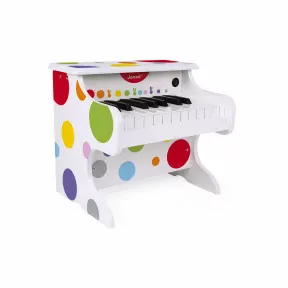
My First Electronic Piano Confetti (wood)
This pretty piano replica with coloured polka dots will delight the youngest musicians from 3 years old who wish to discover the pleasure of the piano and music. Four scores have been provided so that your child can play the piano like a real prodigy (Alouette, Twinkle twinkle little star, Au clair de la lune, Frère Jacques). Your child will also be able to create his or her own music according to his or her imagination thanks to the 18 keys that all make a different sound. Practical, the piano automatically switches off after 2 minutes if your child no longer plays with it. To use this toy in good conditions, you will need 4 LR03 1.5V batteries which are not included. Confetti is a complete range of musical instrument toys with Pop N' Rock designs! Confetti musical toys awaken all the senses and allow the youngest musicians to discover the joys of musical improvisation.
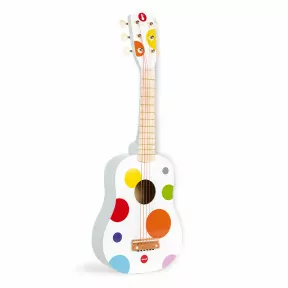
Guitar Confetti (wood)
For the little music fans, here is a wooden guitar for children equipped with 6 metal strings to do like the real rockers! From the age of 3, your children will be able to discover the different sounds this guitar can offer and create their own melodies. Very light and adapted to small hands, it will be perfect to accompany little ones who will take advantage of it to sing their hearts out! Get ready for their first concert in their room. Musical toys allow children to awaken their senses and gain confidence. Confetti is a complete range of musical instrument toys with Pop N' Rock designs! Full of colour and joy, Confetti musical toys allow the youngest musicians to discover the joys of musical improvisation.
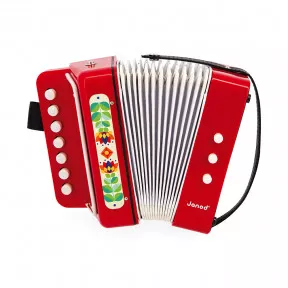
Gioia accordion
Ready for a concert? With this accordion for children aged 3 years and over, the melodies are sure to flow! Ideal for stimulating the imagination, promoting musical experimentation and imitating the greatest... our red accordion has it all! Because gaining self-confidence and expressing your personality also involves musical expression, this pretend play toy will set the tone at home. This accordion is equipped with 7 sound keys, 2 tone-changing buttons and 1 air-releasing button that blows air so little ones can more easily open and close the instrument. Gift this musical toy to your toddler and let their star quality shine! It’s a good opportunity for them to experiment with different sounds and proudly play their first melodies. Bring music into your child's world with this toy accordion! It is part of our Gioia range; a joyful musical awakening is in store for little ones as they discover many a sound in a fun, sharing-focused way.
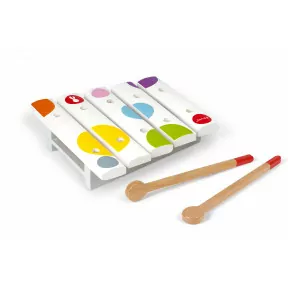
Mini Xylo Confetti (wood)
CONFETTI mini xylophone, 5 notes wooden xylophone with 2 sticks. Red, yellow, green, orange... Confetti, a complete line of musical toys featuring Pop N' Rock designs ! Confetti awakens all of the senses and introduces the youngest musicians to the joys of musical improvisation.
